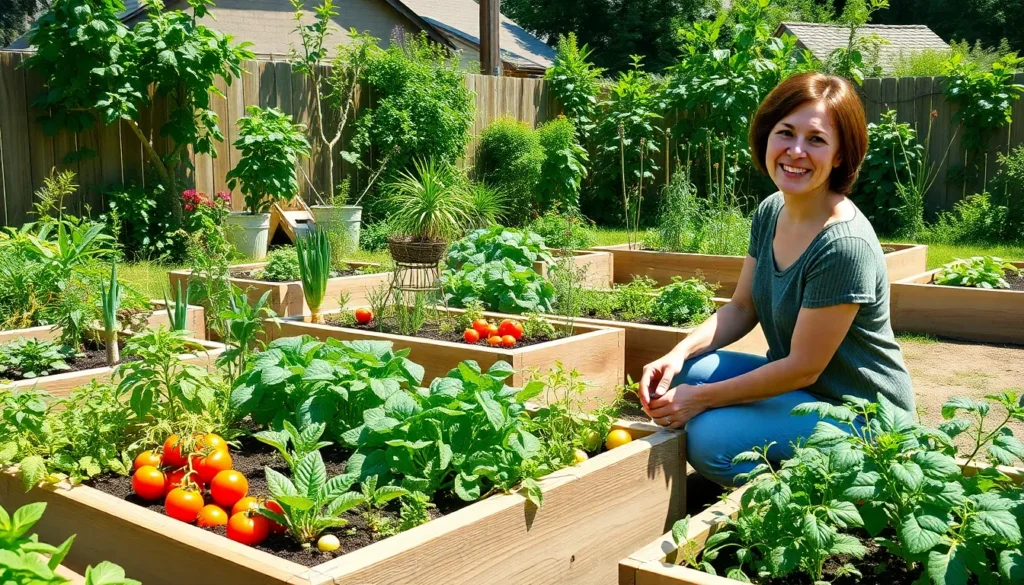Dreaming of fresh tomatoes, crisp lettuce, and herbs right outside your door? We’ve all been there – staring at an empty backyard wondering how to transform it into a thriving vegetable paradise that’s both beautiful and productive.
The truth is, designing a vegetable garden doesn’t have to be overwhelming or require a green thumb from day one. Whether you’re working with a sprawling backyard or a compact patio, the right design approach can maximize your harvest while creating an outdoor space you’ll actually want to spend time in.
We’re here to share proven vegetable garden design ideas that’ll turn your growing dreams into reality. From clever space-saving techniques to layouts that make maintenance a breeze, these strategies will help you create a garden that feeds your family and feeds your soul.
Raised Bed Garden Layouts for Maximum Yield
Raised beds transform vegetable gardening by providing superior drainage, soil control, and easier maintenance than traditional ground-level plots. We’ve identified three proven layouts that consistently deliver exceptional harvests while maximizing your growing space.
Traditional Rectangular Raised Beds
Rectangular raised beds offer the most straightforward approach to organized vegetable growing. Standard dimensions of 4 feet by 8 feet provide optimal accessibility from both sides without stepping on soil. We recommend constructing beds 8 to 12 inches deep for most vegetables, with deeper options for root crops like carrots and parsnips.
Square foot gardening method works exceptionally well within rectangular layouts. Dividing your 4×8 bed into 32 individual square-foot sections allows precise plant spacing and succession planting. Leafy greens like lettuce and spinach thrive in individual squares, while larger plants like tomatoes and peppers require four squares each.
Multiple rectangular beds create systematic garden organization. Spacing beds 2 to 3 feet apart ensures comfortable walkways for maintenance and harvesting. We position beds running north to south for optimal sun exposure, preventing taller plants from shading shorter ones throughout the day.
U-Shaped Raised Bed Configurations
U-shaped raised beds maximize growing space while maintaining easy access from three sides. These configurations work particularly well in corner locations or against fences and walls. Standard U-shaped beds measure 8 feet across the opening with 4-foot-deep arms extending 6 to 8 feet on each side.
Center accessibility eliminates the need to reach across wide growing areas. We can comfortably tend plants throughout the entire bed without compacting soil or straining to reach distant vegetables. This design proves especially valuable for gardeners with mobility limitations or back concerns.
Companion planting opportunities flourish within U-shaped layouts. Positioning tall plants like corn or pole beans along the back wall creates natural wind protection for delicate crops. We plant heat-loving vegetables like peppers and eggplants in the protected interior space, while cool-season crops occupy the more exposed outer edges.
Tiered Raised Bed Systems
Tiered raised bed systems create multiple growing levels that dramatically increase planting capacity. Three-tier designs typically feature beds at 8, 16, and 24-inch heights, allowing different root depths while maintaining visual appeal. We construct each tier 18 to 24 inches wide for comfortable maintenance access.
Cascading water flow benefits all planting levels naturally. Water applied to the highest tier gradually filters down through each level, ensuring consistent moisture distribution. This irrigation efficiency reduces water waste while providing optimal growing conditions for plants at every height.
Diverse crop placement takes advantage of varying light and drainage conditions. We position sun-loving plants like tomatoes and peppers on upper tiers where they receive maximum light exposure. Lower tiers accommodate shade-tolerant vegetables like lettuce and herbs, while the bottom level works perfectly for moisture-loving crops such as celery and bok choy.
Square Foot Gardening Techniques for Small Spaces
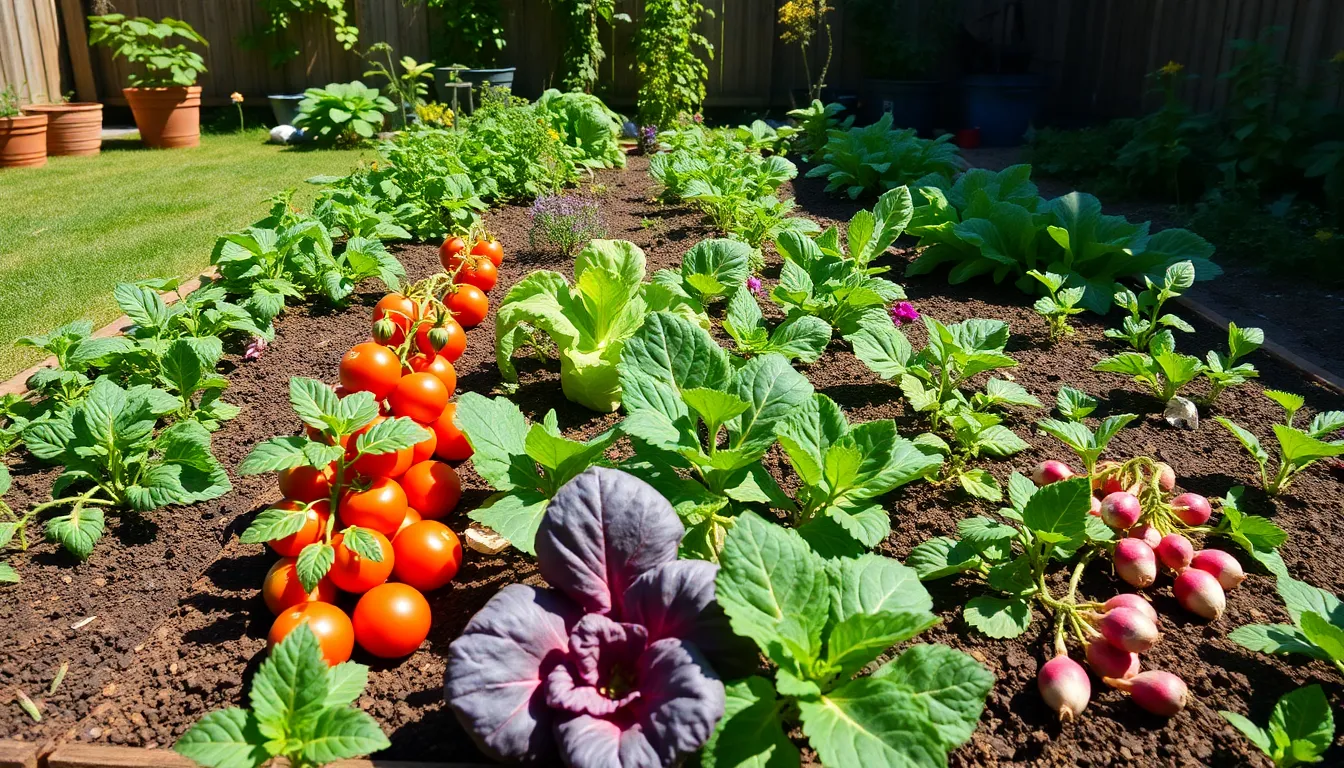
Square foot gardening transforms limited spaces into productive vegetable gardens through strategic organization and planning. We’ll explore three proven techniques that maximize your harvest while minimizing maintenance effort.
Grid-Based Planting Systems
Grid-based planting systems create visible organization within your garden beds using string, wood, or wire dividers. We divide a standard four-by-four-foot raised bed into 16 individual squares, each measuring one foot by one foot. String lines work perfectly for temporary grids, while wooden slats provide more permanent structure for year-round gardening.
Visible separation between planting units allows precise placement of vegetables based on their mature size. We plant one tomato per square, four lettuce plants per square, or sixteen radishes per square depending on each crop’s space requirements. Wire dividers offer durability for gardens that need weather-resistant grid systems.
Enhanced visual appeal comes naturally with organized grid patterns that create neat, structured garden beds. We simplify crop rotation by moving plant families to different squares each season, while succession planting becomes straightforward when tracking which squares are ready for new crops.
Intensive Spacing Methods
Intensive spacing places plants closer together than traditional row gardening without compromising healthy growth patterns. We optimize sunlight, water, and nutrient use by positioning vegetables at calculated distances that prevent competition while maximizing space efficiency. Properly managed intensive spacing increases yield per square foot compared to conventional gardening methods.
Weed suppression occurs naturally when plant canopies shade the soil surface between crops. We reduce the need for frequent soil disturbance by maintaining consistent plant coverage throughout the growing season. Urban gardens and raised beds benefit most from intensive spacing techniques due to controlled growing conditions.
Plant health remains optimal when we follow exact spacing guidelines rather than cramming too many vegetables into limited areas. Fast-growing crops like spinach and lettuce work well with tighter spacing, while larger plants like peppers need adequate room for proper air circulation.
Succession Planting Strategies
Succession planting ensures continuous harvests by timing new crops immediately after previous ones are harvested from the same space. We plant fast-growing vegetables like radishes, lettuce, and spinach between slower-growing crops such as tomatoes or peppers throughout the growing season. Multiple harvests from identical garden squares maximize productivity within single growing seasons.
Strategic timing allows us to plant cool-season crops in early spring, followed by warm-season vegetables, then cool-season crops again in fall. Quick-maturing vegetables like arugula can be planted every two weeks for consistent fresh harvests, while longer-season crops anchor the garden structure.
Space efficiency reaches peak levels when we coordinate planting schedules with harvest dates across different garden squares. Continuous vegetable supply keeps our tables stocked with fresh produce from spring through fall, making the most of every available growing day.
Vertical Growing Solutions for Limited Areas
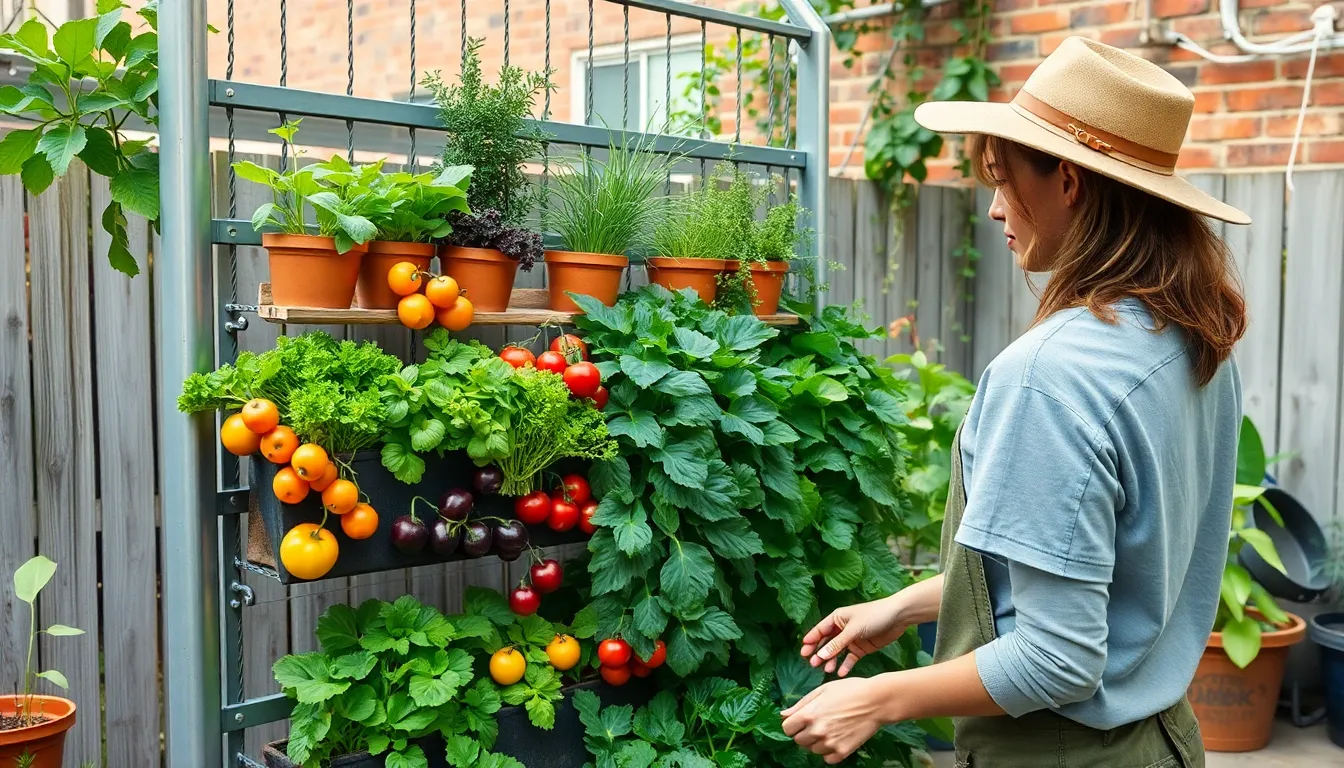
When we’re working with limited garden space, vertical growing techniques transform any small area into a productive vegetable paradise. These space-saving answers let us grow more food in less square footage while creating stunning visual displays.
Trellis and Support Structures
Trellises maximize our vertical growing potential by supporting climbing vegetables like cucumbers, peas, and beans while keeping our pathways completely clear. We can install these support systems along fences, walls, or as standalone structures throughout our garden beds.
Support frameworks work exceptionally well for heavy vining crops such as tomatoes, squash, and melons that need sturdy structures to bear their weight. These climbing plants naturally grow upward when given proper support, freeing up valuable ground space for additional plantings.
Arbors and arches create attractive garden focal points while providing essential support for our climbing vegetables. We’ll find these structures particularly useful in small gardens where every square foot needs to serve multiple purposes.
Wall-Mounted Garden Systems
Wall-mounted planters transform any vertical surface into productive growing space, making them perfect for herbs and small vegetables in compact areas. We can attach these modular systems to fences, garage walls, or building exteriors to expand our growing capacity.
Modular planter systems offer incredible flexibility since we can easily rearrange or expand our vertical gardens as our needs change. Each individual planter attaches securely to walls while allowing us to customize our growing layout.
Fabric pockets and pouches create space-efficient vertical gardens that work beautifully for leafy greens and herbs. These lightweight systems install quickly on any sturdy wall surface and provide excellent drainage for healthy plant growth.
Tower Garden Designs
Vertical garden towers stack multiple planting levels in minimal floor space, creating ideal growing conditions for lettuce, spinach, and fresh herbs. We can position these towers strategically throughout our garden to maximize both sun exposure and harvest convenience.
Hydroponic tower systems combine vertical growing with water-efficient cultivation methods, delivering nutrients directly to plant roots without soil. These specialized towers use significantly less water than traditional gardening while producing impressive yields in compact spaces.
Stackable growing systems let us build upward rather than outward, making them perfect for patios, balconies, and small yard areas. We’ll appreciate how these towers create dramatic visual impact while providing abundant fresh vegetables throughout the growing season.
Companion Planting Arrangements for Healthy Growth
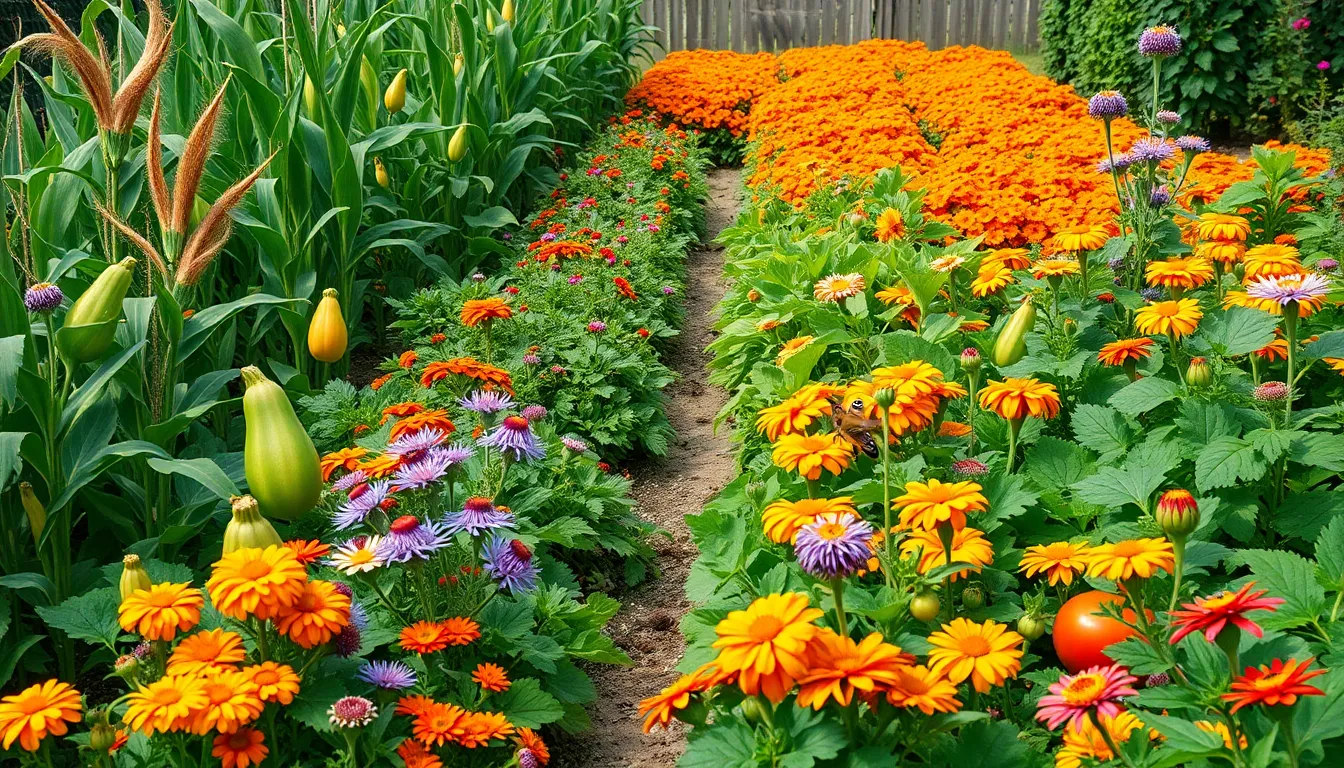
Strategic placement of vegetable plants next to each other maximizes their benefits while minimizing competition for nutrients, water, and space. We’ll explore proven companion planting methods that create healthier, more productive gardens through natural plant partnerships.
Three Sisters Planting Method
Traditional Indigenous wisdom brings us the “Three Sisters” companion planting system involving corn, beans, and squash cultivated together. Corn provides natural support structures for climbing beans to grow vertically. Beans fix nitrogen directly into the soil, feeding both corn and squash with essential nutrients. Squash spreads along the ground surface, creating natural shade for plant roots while suppressing weed growth.
This trio creates a self-sustaining garden network that requires minimal external inputs. We recommend planting corn first, allowing it to reach 6 inches tall before adding beans around the stalks. Squash gets planted around the perimeter, giving it room to spread without crowding the other plants.
Pest-Deterrent Plant Combinations
Certain vegetable and herb combinations naturally repel harmful insects without chemical pesticides. Marigolds planted alongside tomatoes effectively repel nematodes and various garden pests. Basil serves dual purposes by deterring flies and mosquitoes while improving tomato flavor when grown nearby.
Chives discourage aphids from attacking susceptible vegetables like roses and peppers. Carrots paired with onions create mutual protection, as each plant’s scent masks the other from their respective pests. We’ve found that interplanting these combinations reduces pest damage by up to 40% compared to monoculture plantings.
Common beneficial pairs include tomatoes with basil, peppers with borage, and carrots with onions for optimal pest management and soil health improvement.
Beneficial Pollinator Partnerships
Flowers and herbs strategically placed throughout vegetable gardens attract essential pollinators like bees and butterflies. Borage produces blue star-shaped flowers that bees absolutely love while improving the growth of nearby tomatoes and peppers. Nasturtium adds vibrant colors and attracts beneficial insects that control aphids and cucumber beetles.
Lavender provides long-lasting blooms that support pollinator populations throughout the growing season. These pollinator-friendly plants improve fruit set and yield for crops like cucumbers, squash, and melons that require insect pollination.
We recommend dedicating at least 20% of garden space to pollinator plants, distributing them evenly throughout vegetable beds rather than concentrating them in one area. This approach creates biodiversity while making gardens both functional and visually appealing.
Row Planting Designs for Traditional Gardens
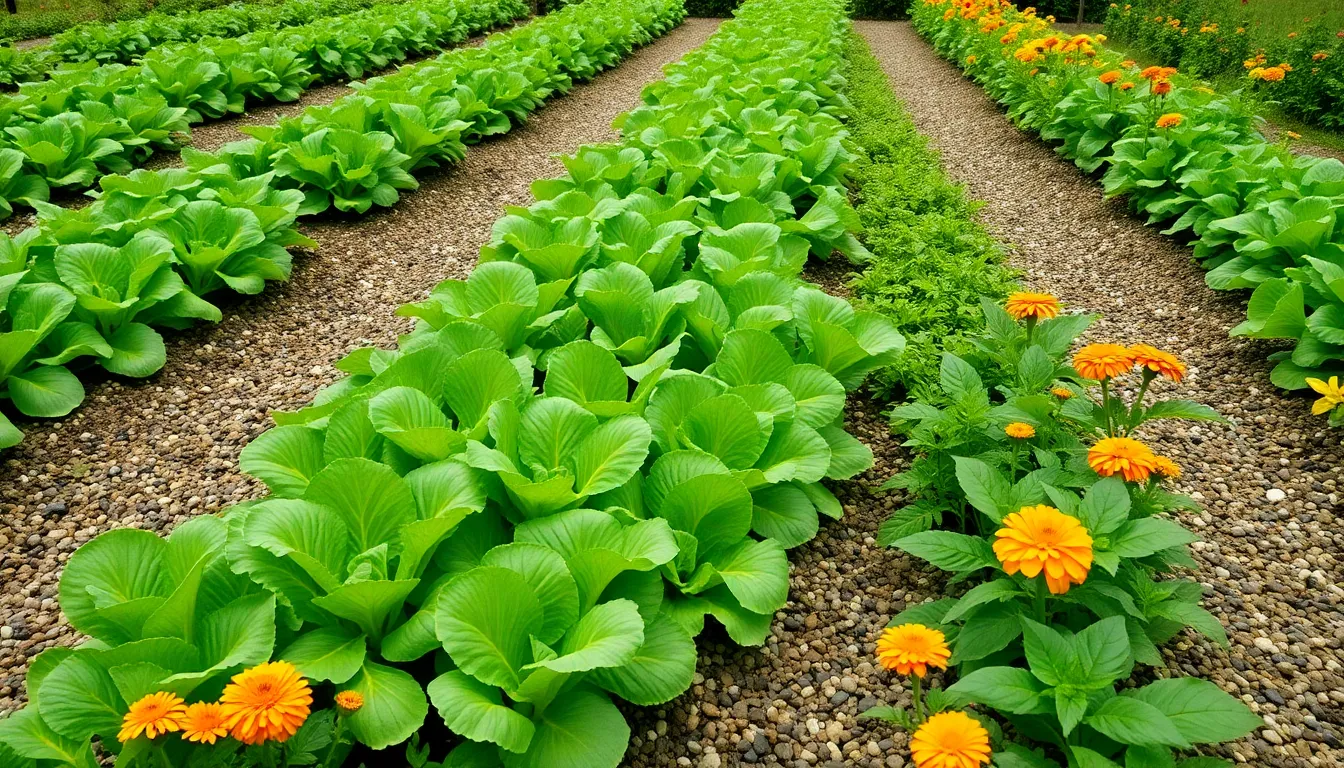
Traditional row planting offers gardeners a systematic approach to vegetable cultivation that’s both productive and easy to maintain. This time-tested method provides clear organization while maximizing our growing space through strategic plant placement.
Wide Row Planting Patterns
Wide row planting patterns revolutionize traditional gardening by clustering multiple rows of vegetables together in block formations. We plant several rows close together within the same bed, typically spacing them just 6 to 12 inches apart instead of the traditional 3 to 4 feet. This method dramatically reduces the amount of pathway space needed while increasing our overall planting area.
Block planting works exceptionally well for smaller vegetables like lettuce, spinach, radishes, and carrots. We can fit three to five rows of these crops within a single wide bed, effectively tripling our harvest potential. The close spacing creates a natural canopy that suppresses weeds and helps retain soil moisture.
Planning becomes crucial when we carry out wide row patterns since we need to ensure adequate light penetration and air circulation. Taller plants should occupy the north side of our beds to prevent shading shorter crops. We also need to consider harvest timing since accessing plants in the center of wide rows requires careful planning.
Intercropping Between Rows
Intercropping transforms empty spaces between our vegetable rows into productive growing areas through strategic companion planting. We plant complementary crops in the pathways and spaces between our main vegetable rows, maximizing every square inch of our garden space.
Fast-growing crops work perfectly as intercrop options between slower-maturing vegetables. We can plant quick-harvest crops like radishes, lettuce, or spinach between rows of tomatoes, peppers, or corn. These fast crops will be ready for harvest long before the main crops need the extra space.
Beneficial companion plants serve dual purposes when we use them for intercropping. Marigolds planted between tomato rows naturally deter harmful insects while adding vibrant color to our garden. Basil intercropped with peppers can improve flavor and repel pests simultaneously.
Timing coordination becomes essential for successful intercropping since we need to harvest intercrop plants before they compete with our main crops. We should plant intercrop vegetables 2 to 3 weeks after our main crops to ensure proper spacing as everything matures.
Pathway Planning for Easy Access
Pathway planning ensures we can navigate our traditional row gardens efficiently while protecting our growing areas from soil compaction. We need to design walkways that provide comfortable access to all plants without creating unnecessary maintenance challenges.
Gravel pathways offer excellent drainage and weed suppression while maintaining a professional appearance throughout the growing season. We recommend using ¼-inch to ½-inch gravel for optimal walking comfort and drainage performance. These pathways require minimal maintenance and prevent mud formation during rainy periods.
Stone pathway installation provides permanent, attractive access routes that complement any garden design. We can use flagstone, stepping stones, or crushed stone to create durable walkways that last for years. Stone materials allow for excellent water infiltration while preventing weed growth between our planted rows.
Raised pathway construction elevates our walking surfaces above ground level, reducing soil compaction and improving accessibility during wet conditions. We build these paths using wooden boards, concrete blocks, or metal edging filled with gravel or mulch. The elevation keeps our feet dry and prevents us from accidentally stepping on planted areas during maintenance activities.
Container Garden Setups for Flexibility

Container gardening offers the ultimate flexibility for vegetable cultivation, allowing us to adapt our growing spaces to changing needs and conditions. We can create productive vegetable gardens anywhere with strategic container selection and placement.
Large Container Combinations
Tiered planters transform vertical space into productive growing areas by stacking containers of varying sizes to create multi-level gardens. We recommend using at least three different container sizes, starting with 20-gallon containers at the base and progressing to 10-gallon containers at the top for optimal stability and visual appeal.
Deep containers accommodate space-hungry vegetables like tomatoes and broccoli that require extensive root systems. We typically use containers measuring at least 20 inches deep and 18 inches wide for these demanding crops, ensuring adequate soil volume for healthy plant development.
Mixed container gardens maximize growing potential by combining vegetables with similar water and nutrient requirements in single large planters. We group plants like peppers, eggplants, and herbs together, or pair lettuce with radishes and carrots for efficient space utilization.
Mobile Garden Cart Systems
Wheelbarrow gardens provide exceptional mobility for our vegetable containers by repurposing old wheelbarrows with proper drainage modifications. We drill multiple quarter-inch drainage holes in the bottom and fill them with nutrient-rich soil to create gardens that move easily to follow optimal sunlight throughout the day.
Portable container systems offer complete flexibility in garden placement by using lightweight containers with built-in wheels or casters. We select containers weighing less than 50 pounds when fully planted, allowing us to relocate our gardens seasonally or respond to changing weather conditions.
Rolling garden carts maximize efficiency by holding multiple smaller containers that we can move together as needed. We typically load 4-6 containers per cart, creating mobile growing stations that adapt to our changing space requirements throughout the growing season.
Hanging Container Options
Hanging baskets create vertical growing space for trailing vegetables like cherry tomatoes and strawberries while adding decorative appeal to our gardens. We use baskets with at least 12-inch diameters and coconut fiber liners to ensure adequate root space and proper drainage.
Gutter gardens transform vertical wall space into productive growing areas by mounting standard rain gutters along fences or building walls. We install these systems at varying heights to accommodate shallow-rooted vegetables like lettuce, spinach, and herbs that thrive in the 4-inch depth gutters provide.
Suspended planter systems use overhead space by hanging multiple containers at different levels from pergolas, deck railings, or tree branches. We space these containers at least 18 inches apart to prevent overcrowding and ensure each plant receives adequate sunlight and air circulation.
Themed Garden Designs for Specific Purposes
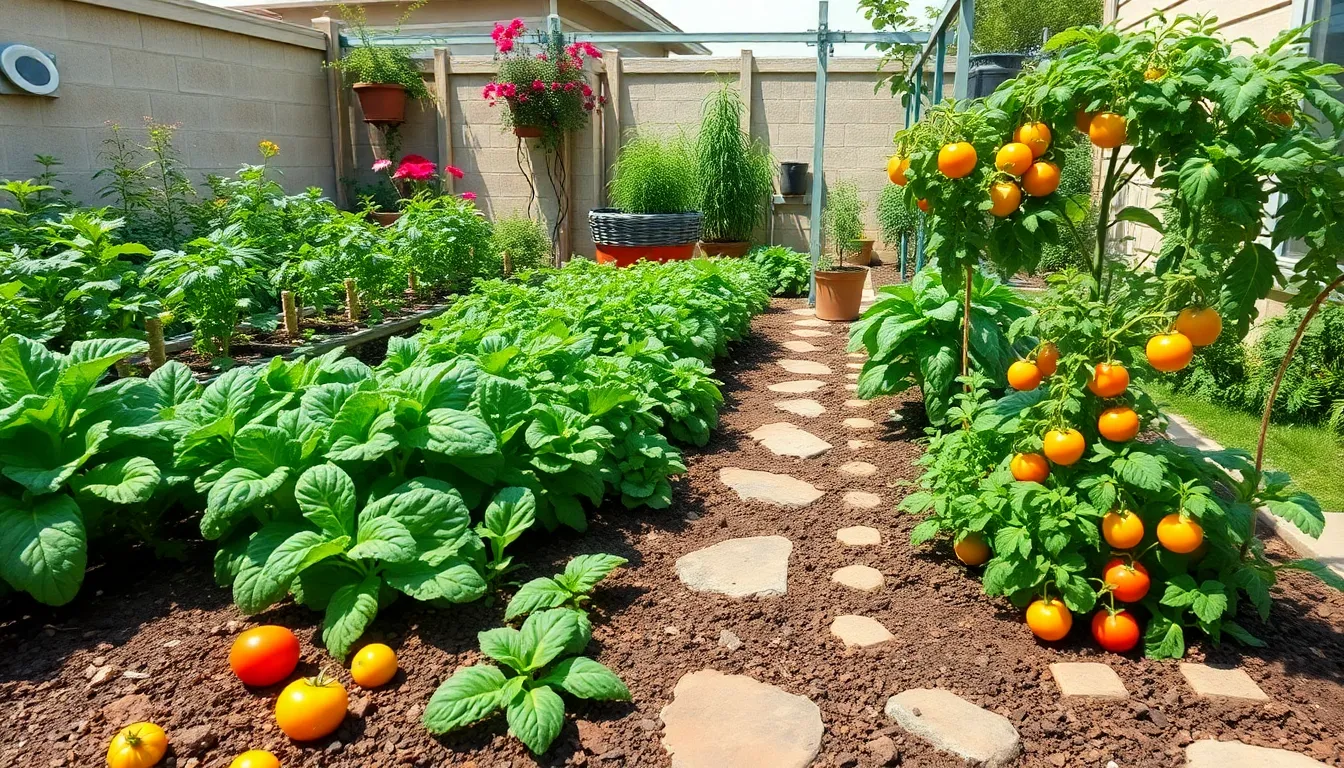
Creating themed vegetable gardens allows us to focus our growing efforts on exact culinary goals while maximizing space efficiency. These specialized designs help us organize our gardens around the foods we love most.
Salad Garden Layouts
Leafy green placement forms the foundation of successful salad garden designs, with lettuce, kale, and spinach taking center stage in our growing beds. We recommend dedicating the majority of our space to these fast-growing greens while incorporating cherry tomatoes and cucumbers around the perimeter for added freshness and texture.
Mixed planting schedules ensure continuous harvests throughout the growing season by combining fast-growing varieties like arugula with slower-maturing plants such as romaine lettuce. This strategic approach means we’ll always have fresh salad ingredients ready for our table.
Container arrangements work perfectly for salad gardens since most greens have shallow root systems, allowing us to create productive growing spaces even in small areas like patios or balconies.
Pizza Garden Arrangements
Tomato varieties anchor our pizza garden design, with cherry, beefsteak, and paste tomatoes providing the essential base for homemade sauces and fresh toppings. We plant these alongside aromatic herbs like basil and oregano to create an authentic Italian flavor profile.
Companion planting maximizes our garden space by strategically placing peppers and onions between tomato plants, creating natural pest deterrents while adding essential pizza ingredients to our harvest.
Vertical support structures optimize growing potential for climbing varieties, allowing us to train tomato vines and pepper plants upward while maximizing ground space for spreading herbs and smaller vegetables.
Herb Spiral Configurations
Spiral design creates visual appeal while providing the perfect microclimate conditions for different herbs throughout our garden space. We build these structures using stones or raised materials, creating drainage variations from top to bottom.
Drainage loving herbs thrive near the top of our spiral, where we plant Mediterranean varieties like rosemary, thyme, and oregano that prefer drier conditions and excellent water drainage.
Moisture loving plants flourish at the bottom of our herb spiral, where we cultivate chamomile, marjoram, and other fragrant herbs that benefit from consistent moisture and rich soil conditions.
Seasonal Garden Planning for Year-Round Harvests
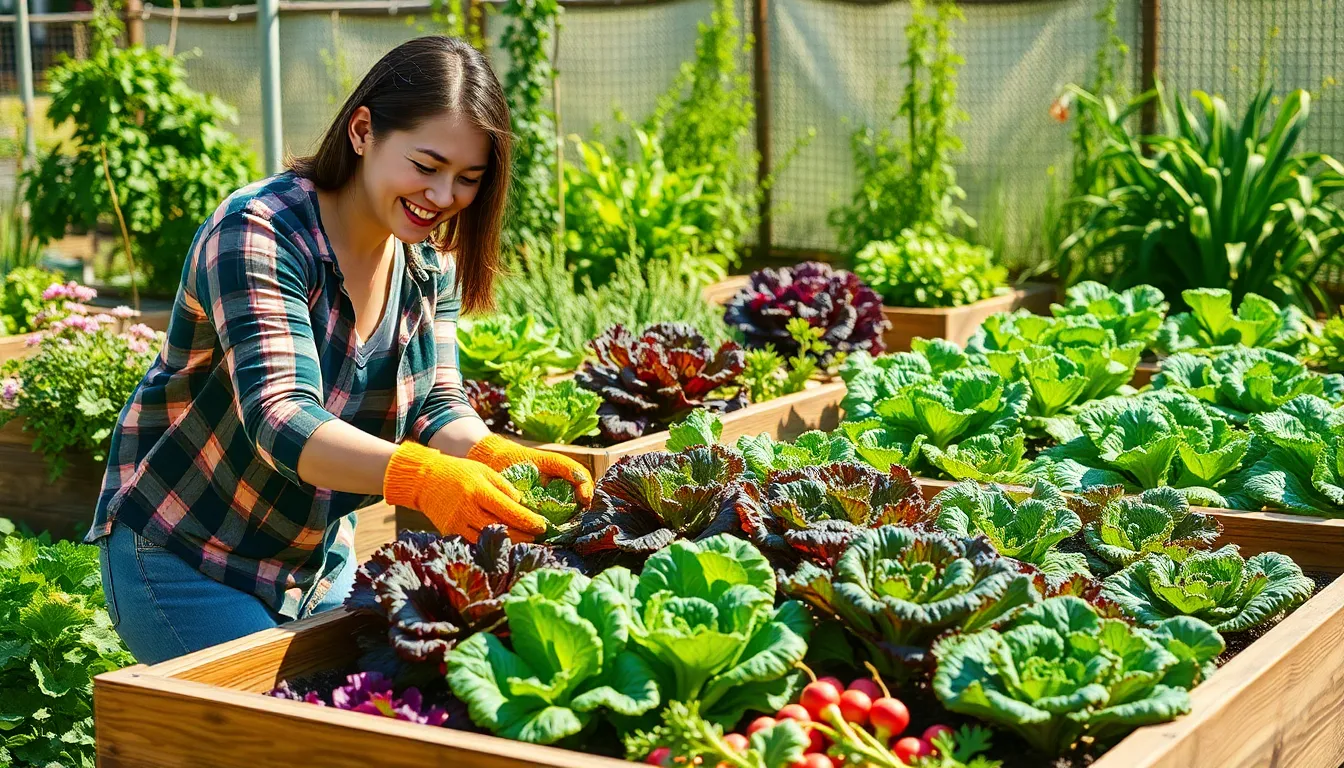
We can maintain continuous harvests throughout the year by strategically planning our vegetable garden layouts for each season. Smart succession planting and crop rotation techniques ensure our gardens remain productive regardless of weather conditions.
Spring Startup Configurations
Early spring gardens flourish when we focus on cool season crops that thrive in moderate temperatures. Lettuce, spinach, peas, radishes, and kale perform exceptionally well during this transition period from winter to summer.
Raised beds offer the ideal solution for spring planting since they warm up faster than traditional in ground rows. We recommend preparing these beds in advance with compost and mulching materials to retain moisture and suppress unwanted weeds.
Companion planting strategies maximize our available space while naturally deterring harmful pests. Mixing lettuce with radishes creates an efficient partnership that optimizes garden real estate and provides natural pest protection.
Summer Heat-Resistant Layouts
Summer gardens require heat tolerant vegetables and strategic design elements to combat intense temperatures. Tomatoes, peppers, eggplant, squash, okra, and basil thrive during the hottest months of the year.
Corn and Armenian cucumber varieties specifically excel in high heat conditions where other crops might struggle. We can arrange these taller plants to provide natural shade for more delicate greens and sensitive seedlings.
Shade cloth with 30 to 50 percent density protects vulnerable plants when temperatures soar. Elevating this protective covering above our plants ensures proper air circulation while reducing heat stress.
Vertical gardening techniques using trellises save valuable ground space while improving air circulation throughout our summer layouts. These structures reduce disease pressure by keeping foliage off the ground and promoting better airflow.
Fall and Winter Garden Designs
Cool weather crops become our primary focus as temperatures begin dropping in autumn and winter months. Broccoli, Brussels sprouts, cabbage, cauliflower, carrots, and beets perform exceptionally well during cooler periods.
Cold frames, row covers, and low tunnels extend our growing season well beyond traditional harvest times. These protective structures shield tender seedlings from frost while maximizing available sunlight exposure.
Strategic bed placement away from tall structures ensures our fall and winter crops receive optimal sunlight during shorter daylight hours. Heavy mulching around plants regulates soil temperature and maintains consistent moisture levels.
| Season | Main Crops | Design Features |
|---|---|---|
| Spring | Lettuce, peas, kale, radish | Raised beds, companion plants |
| Summer | Tomato, pepper, squash, okra | Shade cloth, vertical trellis |
| Fall/Winter | Broccoli, cabbage, beets | Cold frames, row covers, mulch |
Permaculture-Inspired Vegetable Garden Ideas
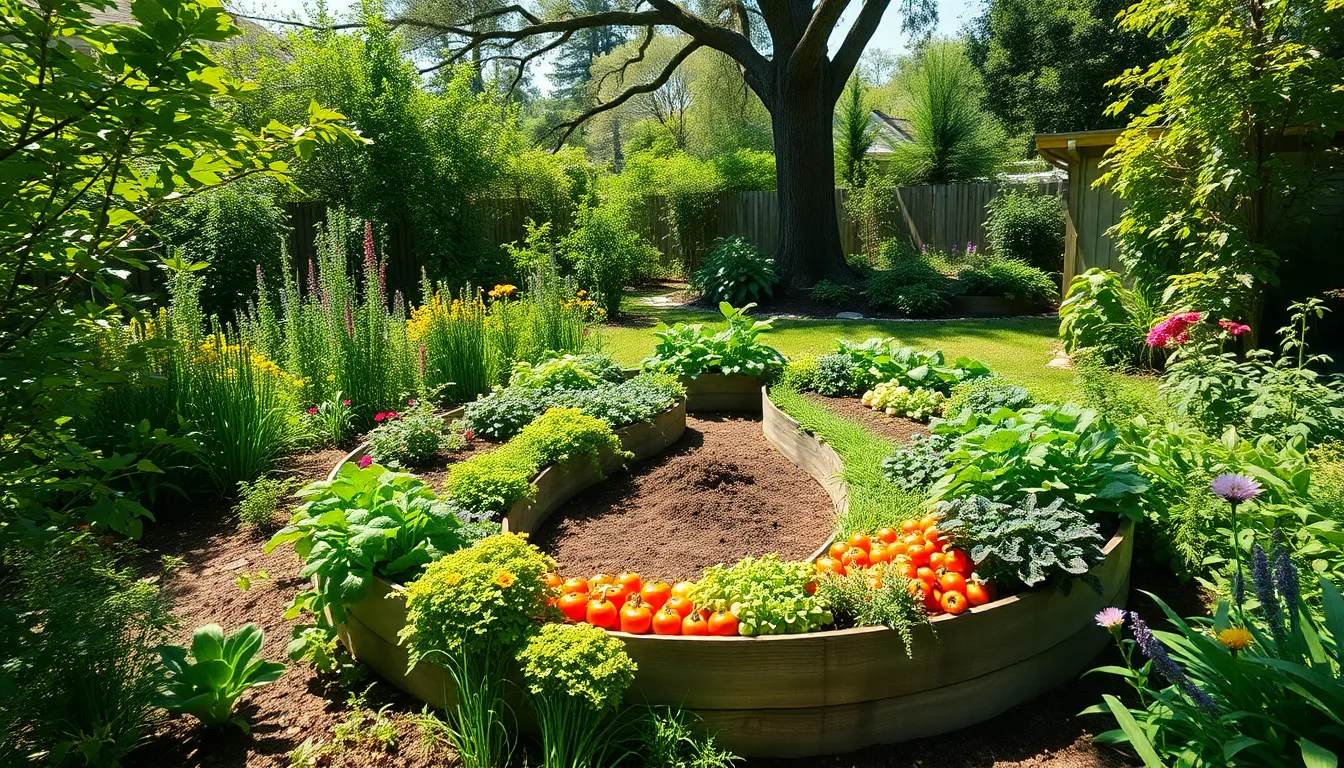
We’ve discovered that integrating permaculture principles into your vegetable garden design creates sustainable, productive spaces that work with nature rather than against it. These innovative approaches maximize growing potential while building healthy soil ecosystems.
Keyhole Garden Structures
Keyhole gardens maximize planting space while minimizing pathways, creating efficient growing systems that provide access from all sides. These circular raised beds feature a central composting area surrounded by growing space, allowing us to tend our vegetables without stepping on the soil.
Design these structures to reach 3-4 feet in diameter with a narrow pathway leading to the center composting basket. We can plant intensively around the perimeter while maintaining easy access for harvesting and maintenance tasks.
Efficient water use becomes automatic when we incorporate the central composting system that captures and distributes moisture throughout the growing area. The decomposing organic matter creates a natural irrigation system that reduces our watering needs by up to 40%.
Accessibility features make these gardens perfect for gardeners of all mobility levels, eliminating the need to bend or reach across large growing areas. We can harvest vegetables from the outer edge while adding kitchen scraps to the central composting area.
Food Forest Understory Gardens
Food forest understory gardens create layered planting systems that mimic natural forest ecosystems while producing abundant vegetables. We plant tall trees as the canopy layer, shrubs as the understory, and vegetables as the ground cover layer.
Layered planting maximizes vertical growing space by combining fruit trees, berry bushes, and shade tolerant vegetables like lettuce and spinach. This approach allows us to grow three times more food in the same square footage compared to traditional row gardens.
Shade and sun management becomes strategic when we use canopy development to control light levels for different crops. We can prevent lettuce from bolting in summer heat by positioning it under partial shade from taller plants.
Integration of climbing vegetables like beans and peas transforms tree trunks and shrub branches into productive growing supports. These vertical elements contribute nitrogen to the soil while providing fresh produce throughout the growing season.
Natural Network Integration
Natural network integration focuses on biodiversity by including plants that attract beneficial insects and pollinators alongside our vegetable crops. We dedicate at least 20% of our garden space to pollinator friendly plants that enhance overall network health.
Soil building techniques like hugelkultur involve burying logs and woody debris to create sponge like water retention systems. These buried organic materials improve soil structure and fertility while reducing our irrigation needs.
Beneficial insect habitat creation happens when we plant native flowers and herbs throughout our vegetable growing areas. Marigolds, nasturtiums, and borage attract predatory insects that control pest populations naturally.
Permanent bed systems minimize soil disturbance while maximizing fertility through continuous organic matter addition. We use the sunniest spots for vegetables, ensuring at least six hours of direct sunlight while maintaining stable soil ecosystems.
Water-Efficient Garden Design Strategies

Building on our sustainable permaculture principles, we can carry out proven water conservation techniques that reduce irrigation needs by up to 50% while maintaining healthy plant growth.
Drip Irrigation Integration
Drip systems deliver water directly to plant roots, minimizing evaporation and runoff that typically occurs with overhead sprinklers. We can install these efficient watering lines beneath our mulch layers to enhance their effectiveness further. Automated timers allow us to schedule irrigation during cooler morning or evening hours when evaporation rates are lowest. This targeted approach ensures each plant receives precise moisture amounts without waste.
Integration with existing garden designs works seamlessly across raised beds, container setups, and traditional row plantings. Pressure compensating emitters maintain consistent water flow regardless of terrain changes or elevation differences in our gardens. We’ll find that combining drip lines with our companion planting arrangements creates optimal growing conditions for plant partnerships like tomatoes with basil.
Rain Garden Vegetable Plots
Rain gardens function similarly to sunken bed designs we’ve discussed, but they specifically capture and retain stormwater runoff for vegetable production. These depressed planting areas allow rainwater to collect naturally and soak into the soil rather than flowing away from our growing spaces. We can position these plots at the bottom of gentle slopes or near downspouts to maximize water collection.
Strategic placement near our homes enables us to direct roof runoff through gutters and downspouts directly into these productive growing areas. Native soil amendments like compost help improve drainage while retaining moisture for extended periods. Rain barrels complement these systems by storing excess water during heavy rainfall for use during dry spells, providing unchlorinated irrigation water that plants prefer.
Drought Resistant Layout Planning
Drought tolerant crops form the foundation of water efficient garden designs, with varieties like Roma tomatoes, Mediterranean herbs such as oregano and thyme, and okra thriving with minimal supplemental irrigation. We should group these resilient plants together in dedicated sections to simplify our watering schedules and reduce overall garden maintenance.
Contour planting and hugelkultur techniques strategically direct available moisture toward plant root zones through gravity fed systems. Mulching materials like straw and newspaper reduce soil evaporation while regulating temperature fluctuations that stress plants during hot weather. Cover crops planted between growing seasons enhance soil health and water retention capacity for future plantings.
Layout planning considerations include positioning water hungry vegetables like cucumbers and lettuce in naturally moister areas while placing drought adapted plants on slopes or elevated sections. We can create microclimates using taller plants to shade moisture loving crops during peak summer heat.
Conclusion
We’ve explored many vegetable garden design approaches that can transform any space into a productive growing area. From raised beds to vertical answers and permaculture principles each method offers unique advantages for different situations and preferences.
The key to successful vegetable garden design lies in choosing techniques that match your available space maintenance preferences and growing goals. Whether you’re working with a small patio or expansive backyard there’s a design strategy that’ll work perfectly for your needs.
Remember that the best garden design is one you’ll actually maintain and enjoy. Start with one or two techniques that excite you most then gradually expand your garden as you gain confidence and experience. Your future harvests will thank you for the thoughtful planning you do today.
Frequently Asked Questions
What are the best raised bed dimensions for vegetable gardening?
Traditional rectangular raised beds measuring 4 feet by 8 feet are ideal for most vegetables. This size allows easy access from both sides without stepping on the soil. The 4-foot width ensures you can reach the center from either side, while the 8-foot length provides ample growing space for proper plant spacing and organization.
How does square foot gardening maximize small space yields?
Square foot gardening divides garden beds into individual square sections, allowing precise plant placement based on size requirements. This grid-based system enables intensive spacing, placing plants closer together than traditional methods. Combined with succession planting, it can triple the harvest compared to conventional row gardening while reducing maintenance needs.
What vegetables work best for vertical growing systems?
Climbing vegetables like beans, peas, cucumbers, and tomatoes thrive on trellises and support structures. For wall-mounted systems, herbs, lettuce, and cherry tomatoes perform well. Tower gardens accommodate a variety of crops including peppers, eggplants, and leafy greens. These vertical solutions can increase growing capacity by 200-300% in limited spaces.
Which plants make the best companions in vegetable gardens?
The “Three Sisters” combination of corn, beans, and squash creates a self-sustaining ecosystem. Marigolds planted with tomatoes deter pests naturally, while carrots and onions protect each other from harmful insects. Include 20% pollinator-friendly plants like sunflowers and zinnias to attract beneficial insects and improve overall crop yields through better pollination.
How do I plan for year-round vegetable harvests?
Practice succession planting by sowing new crops every 2-3 weeks and rotate between cool-season crops (lettuce, kale, broccoli) and warm-season varieties (tomatoes, peppers, squash). Use protective structures like cold frames for winter growing and shade cloth for summer heat protection. Plan spring, summer, and fall/winter garden configurations to maintain continuous harvests.
What is permaculture vegetable gardening?
Permaculture vegetable gardening works with natural ecosystems to create sustainable, self-maintaining gardens. Key features include keyhole gardens with central composting, food forest understory plantings that layer crops vertically, and biodiversity integration with beneficial insects and pollinators. Techniques like hugelkultur soil building and permanent bed systems minimize disturbance while maximizing productivity.
How can I reduce water usage in my vegetable garden?
Install drip irrigation systems that deliver water directly to plant roots, reducing waste by up to 50%. Create rain garden vegetable plots to capture stormwater runoff. Group drought-resistant plants together and use contour planting to optimize moisture retention. Mulching heavily and choosing water-efficient varieties can further reduce irrigation needs while maintaining healthy plant growth.
What are the best container sizes for vegetable gardening?
Use containers at least 18-24 inches deep for root vegetables and 12-15 inches for leafy greens. Large containers (20+ gallons) work well for tomatoes and peppers. Mobile garden carts and repurposed wheelbarrows offer flexibility, while hanging baskets suit trailing crops like cherry tomatoes and herbs. Ensure all containers have proper drainage holes.

